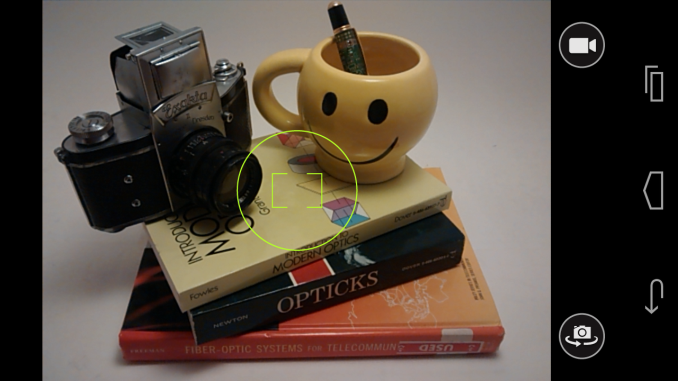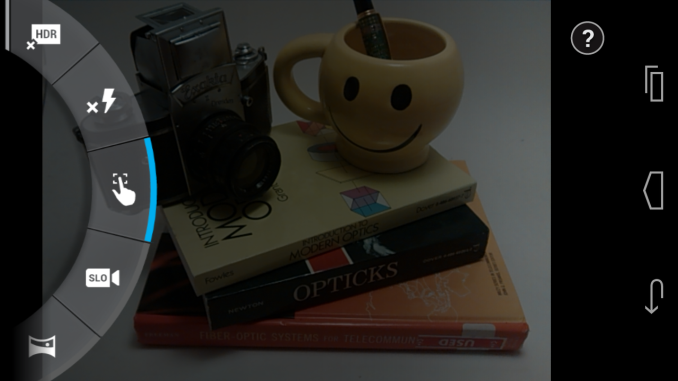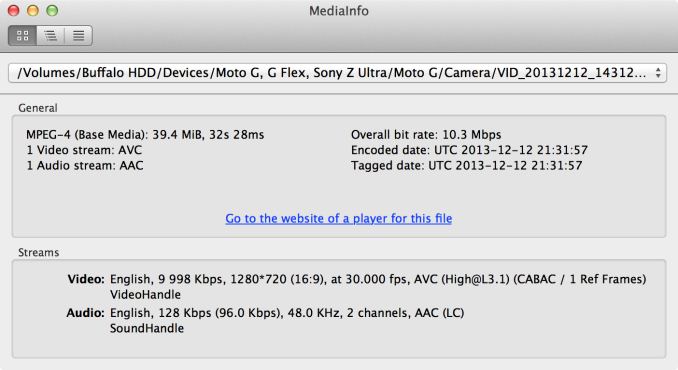Motorola Moto G Review
by Brian Klug on December 18, 2013 2:00 PM EST- Posted in
- Smartphones
- Motorola
- Mobile
- *VA
- Cortex A7
- snapdragon 400
- Moto G
On the camera side the Moto G includes a 5 MP rear facing camera with autofocus and LED flash, on the front it includes a 1.3 MP camera. I did some digging and found that the rear facing camera CMOS is an Aptina AR0543 CMOS. There’s nothing on Aptina’s website about the AR0543, but there is an AR0542 which probably is its predecessor with 1/4 Inch format and 1.4 μm pixels. I suspect this is exactly the form factor of the sensor in Moto G, with some slight improvements, I believe the color filter array is Bayer as well, not RGBW like Moto X. The rear facing camera module has a focal length of 3.5 mm which works out to around a 37mm focal length in 35mm-equivalent units, the system has an F/# of 2.4, which is great for a device of this cost.
On the front is the Aptina MT9M114 1.3 MP, 1/6 Inch with 1.9 µm pixels sensor that we’ve seen a lot of in recent days.
Motorola uses the same camera application as the Moto X, and reflects the most recent UI changes that have rolled out in both OTAs and through the Play Store. The biggest change is a new spot focus and exposure point which can be dragged around the live preview. Motorola calls it manual focus and exposure, in practice it’s really a weighted spot meter and focus point that you can drag around. I’d only call what LG has on the G2 or Nokia bundles as manual focus, but the new camera app is a substantial improvement over the UI as it launched with the Moto X, which didn’t afford any exposure or metering controls (instead taking a scene average), only tap to focus, which ran a full AF search wherever you tapped.
The camera settings menu still is a ring chooser that slides out with a drag from the left side, and has settings for HDR, flash, tap to focus/expose, slow motion video, panorama, location, a new aspect ratio toggle (16:9 and 4:3) and shutter sound. The aspect ratio toggle is what’s new versus the X, since the Moto G has a standard 4:3 aspect ratio sensor and not the 16:9 aspect ratio aspect ratio of the Moto X. By default the Moto G launches with the 16:9 aspect ratio for image capture, cropping off part of the image area, but tapping 4:3 gives you a proper live, full field of view, 4:3 preview. Major kudos to Motorola for giving an aspect-correct live preview. Shot to shot latency is longer than Moto X or other flagships, but not inordinately long or on the order of seconds. I should note that the Moto G does not include the same wrist-flick camera activation gesture as the Moto X.
To evaluate image quality we turn to the usual combination of photos taken at the bench locations, although location 7 wasn’t available, and photo tests in a lightbox with lights on, and off, and of test charts. I also continue to take photos while out and about with devices to get samples in a variety of other conditions.
Moto G still image quality is better than I had suspected. Outdoors in well lit scenes the Moto G is totally capable of delivering good quality shots with good exposure and focus.
My only major criticism is that there’s definitely some off-axis loss of sharpness, the leftmost part of almost every image gets blurry quickly, the right side doesn’t show nearly as much. Alignment tolerances for smartphone optics are a part of module cost, I wouldn’t be surprised to see variance like this. In low light or indoors, the Moto G occasionally struggles to produce images without blur, but that’s a complaint I still levy against some modern flagships. There’s also a bit of light leakage on the Moto G which crops up when outdoors, but nothing crazy. Front facing camera quality is totally par with other flagships I’ve tried, which isn’t surprising.
Camera - Video
On the video side, the Moto G’s interface is, no surprise, just like the Moto X. There’s a video button that immediately starts video capture, successive taps in the image area capture still frames from the live video. Although MSM8x26 supports up to 1080p30 video encode for H.264, Moto G oddly enough captures video at 720p30 in H.264 High profile at 10 Mbps. Audio is stereo thankfully at 128 kbps AAC.
As always I’ve uploaded a copy of the video recorded at the usual place to YouTube and to our servers for you to look at without the additional compression.
Video from the Moto G is well exposed and appears great for being 720p. I would personally miss 1080p, but the Moto G seems great for the resolution it affords. There’s no dropped frames or visible macroblocking, and exposure seems good, again my only desire would be for 1080p resolution.























































120 Comments
View All Comments
bhima - Monday, December 23, 2013 - link
The market are people that, for example, pay only $25 a month each on a T-mo family plan and they don't want to drop an extra $30 a month for 2 years for a phone, Or sign up for a contract with ATT/Verizon and blow easily $60+ a month. 500mb of data at HSPA+ speed (9mbps in my area) with no overage charge, unlimited talk and text for $25 a month makes this phone a huge winner to those willing to look for a good experience without burning a hole in your wallet.teiglin - Wednesday, December 18, 2013 - link
Every time I read reviews of this I'm surprised at how closely MSM8x26 performs to flagships from as recently as last year. Obviously it isn't really in the running compared to 8974, Apple A7, Exynos 5250, etc., much less APQ8064, so I think this says more embarassing things about companies that shipped quad-A9 flagships in mid-to-late-2012, but still, the end result is that the display and silicon leads to an experience comparable to (if not better than) a GS3 i9300. This is pretty surreal at the sub-$200 price point, while a new i9300 still goes for ~$400. Of course there are other sacrifices and if we're talking about $400 life begins and ends with the Nexus 5, but still, Motorola has really accomplished something with the Moto G. This is the phone I'd buy for my son if he were five years older; hopefully by the time he's old enough to have his own smartphone, Motorola will be still have something comparable on sale so he can get a quality device at this price point.teiglin - Wednesday, December 18, 2013 - link
Exynos 5420. Not really sure where 5250 came from, but... thingssayash - Thursday, December 19, 2013 - link
5250 is now more than a year old, it was the soc in the nexus 10, so yeah.Bobs_Your_Uncle - Thursday, December 19, 2013 - link
By the way, how's that Nokia 1020 review coming?Klug4Pres - Thursday, December 19, 2013 - link
Brian, I am curious about the impact of operating system version on the benchmark comparisons. Presumably the results in your tables are based on whatever version was installed at the time of initial testing, which is perfectly reasonable.However, it would be interesting to gauge the impact of, for example, new Android versions on a device's scores. Is there an appreciable change in performance going from, say, 4.2 to 4.3 or 4.4 on Nexus 4?
I realise it would be a lot of work to try to update all benchmarks on every software release across every OEM, and anyway you do not necessarily retain access to most of the devices you test, but this might be feasible on just the Nexus devices, which I have a feeling you tend to keep around. On the other hand, maybe the results aren't really very interesting.
Qwertilot - Thursday, December 19, 2013 - link
Fascinating to see what happens with and its relatives/competition in next few years.In a sane world this sort of thing would take huge chunks of the market for high end phones. The current market with the very expensive ultra high end models selling so much at such premiums surely can't be sustainable long term.
Only thing is that I'm not sure how rational this market is :)
uhuznaa - Thursday, December 19, 2013 - link
With smartphones and tablets becoming a mass-market it will be as rational as any other market. Like clothing, shoes or food. Which means not very rational, there will be room for huge price spans and very different products, some of them rational and others not at all. This is hard to digest for geeks, I know.Qwertilot - Thursday, December 19, 2013 - link
True. The special thing for the mobile market is the rather big locked in distortions via contracts/subsidies etc.Certainly nice to have this sort of option around.
ESC2000 - Monday, December 23, 2013 - link
problem is that the average person thinks s/he needs the newest shiniest most powerful device that she will probably never take advantage of, and the up front subsidy (but pay out the rear) system facilitates the impulse to purchase an overly powerful device in the US by making Americans less price sensitive. It is really annoying to listen to people who think a small very powerful computer that pushes more pixels than their laptop only costs - and should only cost - $200 at most.